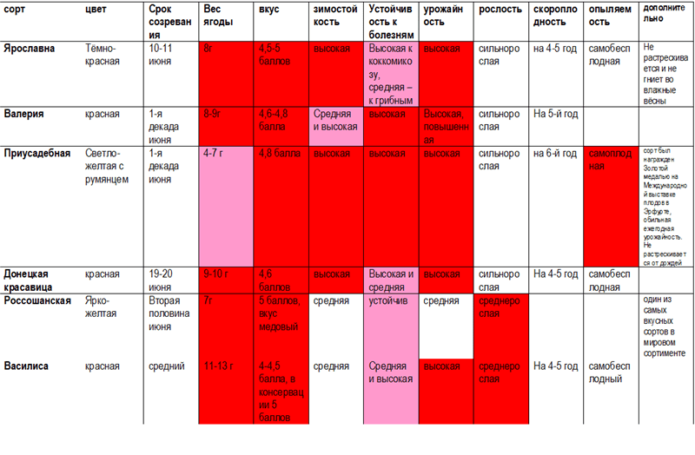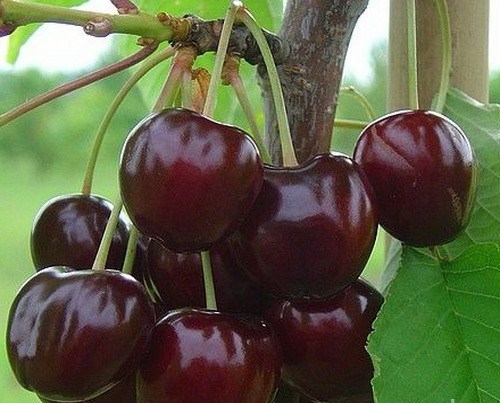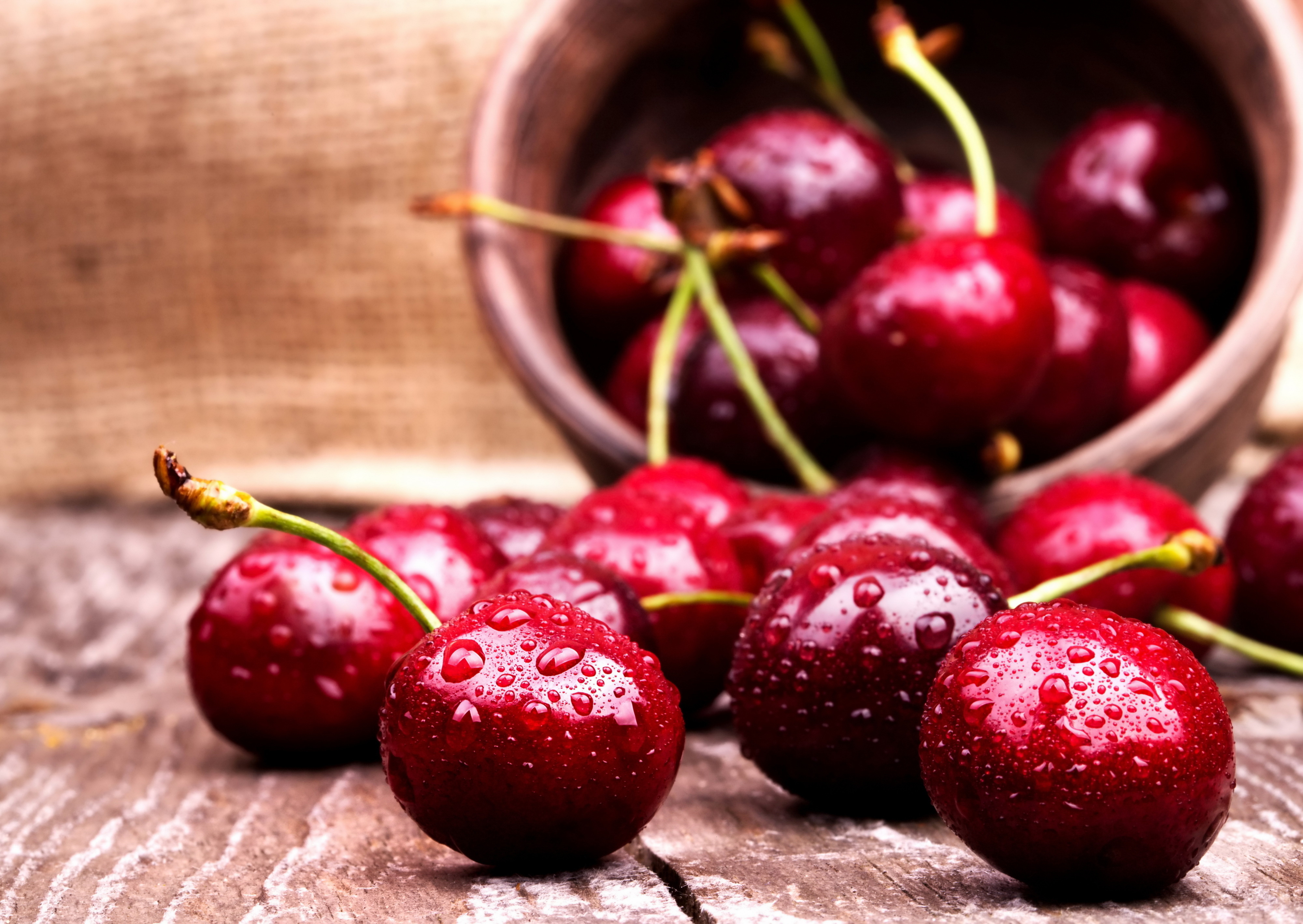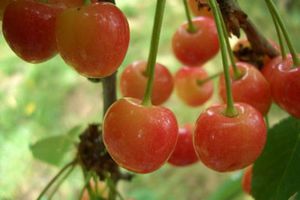There is such a game. For each letter chosen, three fruits, vegetables or berries are called. For example, three berries per "h". Answer: bird cherry, chokeberry, cherry. Cherries. You say this word, and your lips involuntarily stretch into a smile. And how can you not smile! Juicy, fragrant berries invitingly shine with an elastic barrel. How great summer is! You can continue the game, developing your horizons, but it is better to climb a tree and pick up ripe berries. Here is a cherry with dark, as if varnished berries, Yaroslavna. The game is over, beauty, hold on!
Content
The history of the origin of the variety
Sweet cherry Yaroslavna was obtained in the seventies of the last century by the breeder Lilia Ivanovna Taranenko. A variety was bred from seedlings of Drogana yellow in the Donetsk branch of the Institute of Horticulture of the UAAS (Ukrainian Academy of Agrarian Sciences). The fate of Lilia Ivanovna, the Honored Agronomist of Ukraine, who has worked here in the same position for more than six decades, is amazing.
Over the years, out of dozens of varieties, L.I. Taranenko 21 - zoned, of which 19 - in Ukraine and six - in Russia. Taranenko's stone fruit varieties are grown in the CIS countries, Western Europe, China, and the USA. One of her varieties of plums was received in the late 1980s. gold medal at the Erfurt exhibition in Germany. She is the author of over 100 scientific articles. But, for all her achievements, Lydia Ivanovna was not even a candidate of sciences.
Having such a selective “fertility”, Lidia Ivanovna chose to remain a practicing gardener, infinitely devoted to her work, until her death in 2012.
Here is a list of the varieties of Lydia Taranenko, which domestic gardening can be proud of:
- Sweet cherry - Early pink, Dzherelo, Valeria, Yaroslavna, Farewell, Lesya, Donetsk beauty, Vasilisa, Donchanka, Annushka, Aelita, Ethics, Katyusha, Donetsk coal, Sister, Amazon, Student (early-growing, excellent taste, with fruit weight up to 8– 9 g, part - up to 12-14 g).
- Cherry - Wonder cherry, Donetsk Shpanka, Nochka, Donetsk giant, Ksenia, Temptation, Slavyanka (weight of some varieties of fruits from 7 to 9 g).
- Plum - Titmouse, Early Renklod, Karbyshev's Renklod, Early Donetsk Hungarian, Donetsk Hungarian, Donetsk Canned.
- Turn - Donetsk Turn, Large Donetsk Turn.
- Cherry plum - Superearly, Chernushka, Early Donchanka, Mashenka, General, Tatiana, Plum, Velvet, Harmony, Naydenysh, Lemon, Sunny Bunny.
- Apricot - Son of Tabarza, Frost-resistant, Donetsk sweet-core.
- Peach - Donetsk white, Donetsk yellow, Stark's seedling.
- Quince - Donetsk pear-shaped.
- Apple tree - Kalvil Donetsk (surpassed the parent - Renet Simirenko - in early maturity and yield).
Since 1997, Yaroslavna sweet cherry has been included in the State Register and recommended for cultivation in the North Caucasus region and Crimea.
Description cherry Yaroslavna
The tree is of medium height, with a round crown of medium leafiness. Shoots branch well, arched, thick, brown.The leaf blade is medium, ovoid, dark green, with a shiny surface and serrated edges. The corolla of the flower is white, up to 3 cm in diameter. Two to five flowers are collected in umbrella-type inflorescences.
Fruits are round, slightly tapering at the top, dark red. The bone is small. The mass of one berry ranges from 7-8 g. The pulp is juicy, sweet, dark red in color. The pulp contains slightly more than 13% dry matter, almost 10% sugar, 9 mg /% vitamin C, there is also iron, copper, vitamin PP and carotene. The berries have high tasting characteristics and are well transported. They are very tasty fresh, at the same time they retain their color and aroma during canning.
Sweet cherry Yaroslavna is an early ripening variety. From one hectare of planting it gives 119 centners of berries. Winters well and tolerates drought. Wood and flower buds are also highly frost-resistant. The variety is not strongly affected by fungal infections, and the thunderstorm of all old varieties - coccomycosis - is not terrible for Yaroslavna.
Saplings begin to bear fruit by the fifth year, and by the age of ten they yield up to a centner of berries from a tree.
Features of growing and care
Yaroslavna is planted on the southern or southwestern, well-lit slopes protected from northern winds. Sweet cherry can grow in partial shade, but does not like too shaded lowland areas. Yaroslavna, like other varieties of sweet cherries, prefers light soils: sandy, sandy loam or loam, slightly acidic or neutral. The soil should be fertile and warm well. The groundwater level is no closer than two meters. He also loves liming cherries, this is a feature of all stone fruit crops. By introducing dolomite flour, we kill two birds with one stone: the acidity of the soil decreases and lime is introduced.
Choose one-year cherry seedlings and start planting in early spring:
- Mark the distance between cherry seedlings at least 3-4 meters.
- Dig a hole 80x80x70 cm in size.
- The topsoil is separated from the infertile bottom layer.
- First, rubble is poured onto the bottom of the pit for drainage.
- A bag of dolomite flour is introduced into each hole.
- Compost, humus or peat are added to the fertile soil, in equal amounts, part of this mixture is thoroughly mixed with dolomite flour in a hole, and a mound is formed.
- The planting peg is first fixed on the mound, then the seedling is planted.
- They indicate the level of the surface of the planting hole and fill in the soil mixture, periodically shaking the seedling so as not to leave voids. This is done in the case when seedlings with an open root system are planted, if a tree is planted from a container, then they are simply planted carefully, trying not to damage the earthen ball.
- Thoroughly compact the earth around the seedling, forming an irrigation hole.
- Tie the seedling to a peg.
- Water abundantly with at least two buckets of water.
- The trunk circle is mulched with humus, sawdust or peat to reduce moisture evaporation.
Video: correct planting of cherries
Further watering is done as needed. It is important to provide plants with watering during flowering, setting berries, immediately after harvest. In the early years, vegetable crops and legumes are often planted in the aisles of plantings, making an annual crop rotation. In the future, as the trees grow, care is reduced to loosening the trunk circle and pruning.
It is recommended to form the sweet cherry in the form of three- or four-stemmed bushes. To avoid gum lesions, cherries are pruned only in dry, warm weather at the beginning of summer. A stem is formed at least 60 cm. The branches are cut by a third or half, while the lateral branches are cut to the outer bud, shortening them by about one length. The main shoot, the guide, is left 20-30 cm longer. In the future, only annual shortening of the branches is required, which will restrain the growth of the cherry and stimulate the harvest.All pruning is done only at the beginning of summer: later manipulations can lead to drying out of the tree, disease and, ultimately, to its death.
To protect cherries from spring frosts and sudden changes in temperature, it is recommended to whiten it as high as possible in early spring: both trunks and skeletal branches. You can cover and tie young trees in the early years. INIn the spring, you should also not rush to prune frozen branches, it is better to prune in late spring, when the leaves are completely blooming and warm dry weather sets in. It is always recommended to lubricate the slices with garden pitch to prevent infection. Cracks in the trunk, sunburns, it is advisable to clean up to healthy wood and process with pitch.
Table: pests of sweet cherries Yaroslavna
| Pest | The nature of the defeat | Processing period | Means of struggle | Preventive measures |
| Cherry fly | Damages fruits. Leads to a decrease in yield by 90%. | At the beginning of the flight of flies. |
| Spraying with Actellik (2 ml per 2 l of water) or Fury (2.5 ml per 10 l of water) before flowering, twice with an interval of 20 days. |
| Black aphid | Damages leaves by sucking out nutrients from them. | As soon as the pest is discovered and until the complete destruction of the pest, every 5-7 days. |
|
|
| Cherry pipe wrench | Damages buds, buds and ovaries. It lays the larvae in the fruit, which then gnaws at the seeds and feed on the nuclei of the fruit. | As the pest is detected. |
| Spraying the tree with Aktara insecticide (1.4 g per 10 l of water) after flowering 2 times with an interval of 14 days. |
Yaroslavna suffers not so much from diseases as from feathered lovers of sweet berries. To protect the crop, experienced gardeners recommend pulling fishing nets over the crown or placing birds of prey on the site.
Yaroslavna is a self-fertile variety. Good pollinators for her are: Annushka, Valeria, Valery Chkalov, Donetsk beauty, Donchanka. In the absence of these varieties, Aelita, Drogana yellow, Melitopol early, Donetsk coal are suitable for pollination.
Reviews
Yaroslavna - mid-early blooms in the middle. Donetsk coal is a medium-late variety, but it blooms mainly in the early period, in some years, in cool weather, it can bloom in the middle period. I would, of course, choose Yaroslavna, she does not need to be sprayed from a cherry fly. But if it is not there, then DU as a pollinator is also suitable.
I buy fruits and berries only in the nursery. Yaroslavna, as I was told and I read, is a frost-resistant variety.
Cherry Yaroslavna:
- Ripening period - 2 ten days of June.
- Fruit weight and color - 8 g, dark red.
- Growth Strength - Medium.
I just went to the exhibition yesterday, bought a pollinator to Valery Chkalov ... I found on the net that Yaroslavna would do.
There are many reports that gardeners are not abandoning their attempts to propagate southern cherry varieties in regions significantly north of their natural habitat. The problem is that cherries have a long growing season, due to this, the tree does not have time to prepare for winter. It is believed that seedlings grown from seeds are better adapted to growing conditions.But do not forget, cherries, as a rule, are grafted onto cherries and you can find out what has grown from a seedling only after fruiting.
Although everyone around them asserts that Yaroslavna is a southern touch-me-not, I want to believe: someone will get a harvest of dark fragrant berries in central Russia. After all, if you manage to collect sweet watermelons and melons, grapes and apricots here, maybe it will work out with cherries.







